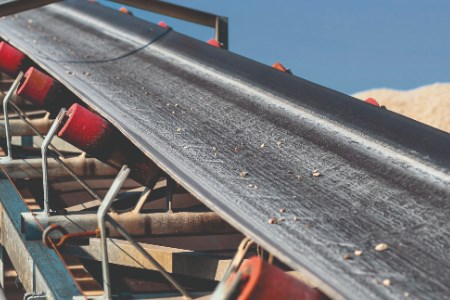Conveyors play a crucial role in the efficient, cost-effective, and environmentally-friendly transportation of materials in large-scale mining.
Conveyor installations are used across mining operations wherever there is a requirement for the continuous transportation of bulk materials from place to place. They are found between the mine pit and processing facilities, within processing operations, and as downstream links to ports, railheads, and other logistics facilities.This wide range of applications has led to significant diversity in size, capacity, and technology. The highest capacity conveyor systems in German lignite mines can transport 40 000 tph of material, or 240 000 m3 per day. Overland conveyor systems can span distances of tens of kilometres. The world’s longest conveyor carries phosphate 98 km from the Bou Craa mine in Western Sahara to the port at El Marsa. In the sparse desert landscape, this conveyor installation is large enough to be visible from space.ChallengesDespite their ubiquity, conveyor systems can be troublesome for mine operators. Failure rates are among the highest of any asset type used in the industry. Problems with conveyor systems have the potential to influence the overall throughput of a site. In 1Q23, for example, the failure of a conveyor linking the mine to the concentrator at Rio Tinto’s Kennecott copper mine in Utah contributed to a 36% reduction in production.Working on conveyors can also be hazardous for mine personnel. Industry studies have found that 43% of accidents and 24% of all fatalities occur while maintenance is done on conveyors.Equipment manufacturers have invested significant resources to improve the safety and reliability of mining conveyors. Advances in the sector include embedded sensors in belts to detect wear and damage, sophisticated control systems, and gearless drives that claim higher efficiency and greater long-term reliability.Bearing challengesEnsuring the reliability and durability of core conveyor mechanical components remains a key challenge for mine operators.In part, this is due to the high number of these units required in every conveyor. Carrying idlers, used under the loaded side of the belt, are installed every 0.6 m to 1.7 m along the length of the conveyor system, depending on the bulk density of the transported material. Typical spacings for return idlers, which support the unloaded side of the belt, are 2.4 m to 3.0 m. Long overland conveyors may use larger spacings to reduce costs.Each idler frame may include multiple rollers to hold the belt in an appropriate shape, and each of those rollers is equipped with two bearings. Large conveyor installations require many thousands of bearings. One recent overland conveyor project in Australia used around 150 000 SKF bearings in its construction.Conveyor idler bearings work in difficult conditions. These units operate under high loads at low or medium speeds, in widely varying temperatures and with exposure to significant contamination from water, dust, and debris. In addition, the bearing assembly must be able to tolerate misalignment due to the imposed loads, thermal expansion of conveyor components, and assembly tolerances.Enjoyed what you’ve read so far? Read the rest of the article and the April Issue of Global Mining Review by registering today for free!
Read the article online at:
This article was published by:
Visit the original article here



